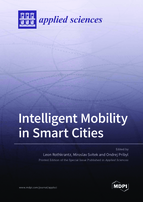Intelligent Mobility in Smart Cities
A special issue of Applied Sciences (ISSN 2076-3417). This special issue belongs to the section "Computing and Artificial Intelligence".
Deadline for manuscript submissions: closed (15 January 2022) | Viewed by 26747
Special Issue Editors
Department of Transport Telematics, Faculty of Transportation Sciences, Czech Technical University in Prague, Konviktská 20, 111000 Praha
Interests: artificial intelligence for smart cities
Interests: telematics for smart cities
Special Issue Information
Dear Colleagues,
Urban areas are growing all over the world. As a consequence, a larger volume of people and goods has to move to a larger number of different locations on a daily basis. This leads to more traffic congestion, longer commutes, use of different travel modalities, and increasing pollution. There is thus a need for more intelligent transportation and smart infrastructure, as well as changes in travel behavior. The following topics are under research:
- To measure the traffic streams, many sensors have been installed on the surface of the road, in smart cameras, smart phones or even vehicles. The sensed data can be stored and processed in a local, central or distributed way in an (semi-)automated way. The Internet of Things and cooperative vehicles will play an increasing role in communication in smart cities;
- To model (future) traffic streams, a smart city can be simulated and used as a testbed for new routing algorithms and as a living lab environment;
- In many applications, car drivers and automated cars are modeled as agents, living in a virtual environment. In these virtual environments, agents share common data, process these data, and consult individual car drivers;
Given the increasing dust pollution in urban regions, it can be expected that less polluting transport modalities will be used, such as electrical cars and bikes. New green areas must be designed, and green routes will be designed via green areas.;
- A smart city should be prepared for disasters. A disaster plan should be available, including an evacuation plan along disaster routes, and this in cooperation among particular city domains such as transportation, energy management, water and waste management, and others;
- In order to effectively decrease the negative impact of urbanization, municipalities shall use policies to address travel behavior in a way that shifts (in time and space) or even decreases travel demand. This can be done, for example, through digitalization of activities (home office, eGovernment) and better accessibility of activities through more effective urban planning.
Prof. Leon Rothkrantz
Prof. Miroslav Svitek
Prof. Ondrej Pribyl
Guest Editors
Manuscript Submission Information
Manuscripts should be submitted online at www.mdpi.com by registering and logging in to this website. Once you are registered, click here to go to the submission form. Manuscripts can be submitted until the deadline. All submissions that pass pre-check are peer-reviewed. Accepted papers will be published continuously in the journal (as soon as accepted) and will be listed together on the special issue website. Research articles, review articles as well as short communications are invited. For planned papers, a title and short abstract (about 100 words) can be sent to the Editorial Office for announcement on this website.
Submitted manuscripts should not have been published previously, nor be under consideration for publication elsewhere (except conference proceedings papers). All manuscripts are thoroughly refereed through a single-blind peer-review process. A guide for authors and other relevant information for submission of manuscripts is available on the Instructions for Authors page. Applied Sciences is an international peer-reviewed open access semimonthly journal published by MDPI.
Please visit the Instructions for Authors page before submitting a manuscript. The Article Processing Charge (APC) for publication in this open access journal is 2400 CHF (Swiss Francs). Submitted papers should be well formatted and use good English. Authors may use MDPI's English editing service prior to publication or during author revisions.
Keywords
- intelligent mobility
- sensor city
- travel behavior
- green city
- disaster plans
Benefits of Publishing in a Special Issue
- Ease of navigation: Grouping papers by topic helps scholars navigate broad scope journals more efficiently.
- Greater discoverability: Special Issues support the reach and impact of scientific research. Articles in Special Issues are more discoverable and cited more frequently.
- Expansion of research network: Special Issues facilitate connections among authors, fostering scientific collaborations.
- External promotion: Articles in Special Issues are often promoted through the journal's social media, increasing their visibility.
- Reprint: MDPI Books provides the opportunity to republish successful Special Issues in book format, both online and in print.
Further information on MDPI's Special Issue policies can be found here.








